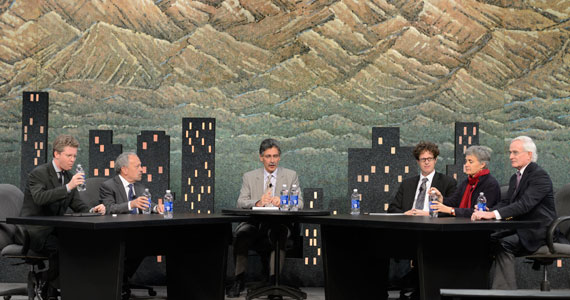
Predictions for the Future

On October 19, 2012, plenary panel participants at the Urban Land Institute’s (ULI’s) Fall meeting in Denver, Colorado, shared their visions for the future of land-use policy and the U.S. economy. Asked to predict what’s next by the moderator--the diverse panel discussed making change happen in the new economy. HUD Secretary Shaun Donovan led off the conversation by stressing the need to build strong, inclusive, and resilient communities that are socially and economically sustainable. To accomplish this goal, he noted, government and private stakeholders will need to intervene in the communities that bore the brunt of the economic recession; areas with the highest foreclosure rates often have the most distressed housing, lowest performing schools, and the least access to public transportation. He noted that greening homes through community leadership and innovative solutions will in turn drive the transformation of private-sector capital markets. In discussing regionalism, his last theme, Secretary Donovan noted that the Denver FasTracks light rail initiative was a game-changing example of how to create successful metropolitan-wide economic development solutions.
Joining Secretary Donovan on the panel were Robert B. Reich, professor of public policy at the University of California at Berkeley and former secretary of the U.S. Department of Labor; Robin Chase, founder and chief executive officer of Buzzcar and cofounder and former chief executive of Zipcar; and Thomas Murphy, a ULI senior resident fellow and former mayor of Pittsburgh and Peter Byck, director and producer of the film Carbon Nation.
Reich continued the regionalism theme, observing that competing jurisdictions within a metropolitan area are less likely to engage in cooperative efforts that further common goals. He particularly stressed the need for education, pointing out that success in manufacturing and job creation requires value-added productivity. Reich offered Germany as an example of a country with a higher median annual income than in the United States because its investment in technical education supports a thriving manufacturing sector and creates that added value to production.
Chase predicted that smart devices and collaborative consumption — a model that allows individuals to market their skills and assets directly to other consumers — would drive the new economy. She noted that alternatives to traditional hotels such as Airbnb, an online service through which users can rent out their homes by the night, had the potential to upend the corporate hospitality sector—providing 650,000 rooms in 192 countries in one year. Another example of the collaborative consumption movement, she noted is carpooling through blablacar. Uber, a car-for-hire service that allows customers to arrange their rides directly with drivers through their smartphones, eliminating the need for a traditional dispatch service and giving complete control of the transaction to the consumer was described by Chase as a singular example of this new economy.
Murphy stressed the need for a new breed in the public sector. He suggested that an entrepreneurial culture within government and universities were vital to a community’s success. He predicted that in the future cities will be managed in a different market driven way.
Finally, Byck noted that many people who dispute the notion of global warming nevertheless value measures that lead to a cleaner environment and conservation of resources. “There are a lot of people who are not buying the climate change argument, but they’re doing amazing things,” he said — a point reinforced in his film Carbon Nation.
What’s Next? Getting Ahead of Change, a publication marking ULI’s 75th anniversary that was released at the ULI Fall meeting, stressed that neighborhoods that connect most directly and easily to urban nodes and downtown centers will gain economic advantages over less convenient exurban locations. As a result, the authors predict “that the target sites for developers and homebuilders will shift over the next generation from the fringe to infill, with an emphasis on creating greater convenience in attractive communities.” As Secretary Donovan emphasized, places that are the least connected will be the most challenged.
PD&R Leadership Message Archive
International & Philanthropic Spotlight Archive
Spotlight on PD&R Data Archive
Publications
Collecting, Analyzing, and Publicizing Data on Housing Turnover
Resilience Planning: What Communities Can Do to Keep Hazards from Turning into Disasters
Cityscape: Volume 26, Number 3
Case Studies
Case Study: Former School in Charleston, South Carolina, Transformed into Affordable Housing for Seniors
Case Study: Avalon Villas Combines Affordable Housing and Services for Families in a Gentrifying Phoenix Neighborhood

The contents of this article are the views of the author(s) and do not necessarily reflect the views or policies of the U.S. Department of Housing and Urban Development or the U.S. Government.
Note: Guidance documents, except when based on statutory or regulatory authority or law, do not have the force and effect of law and are not meant to bind the public in any way. Guidance documents are intended only to provide clarity to the public regarding existing requirements under the law or agency policies.



